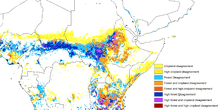Geo-wiki
| Original author(s) | IIASA, University of Applied Sciences Wiener Neustadt, University of Freiburg |
|---|---|
| Website | www.geo-wiki.org |
Geowikis is a wiki created to aid in both the validation of existing geographical information and the collection of new information through crowdsourcing.[1] Due to the existence of Google Earth (and similar applications like OpenStreetMap), geo-tagged images and the internet, individual volunteers are now able to contribute to information about geography and locations.
Background
The Geo-wiki Project is a global network of volunteers who wish to help improve the quality of global land cover maps by adding information on species distribution, habitat, ecosystems and other scientific land use information. Volunteers are asked to review hotspot maps of global land cover disagreement and determine, based on what they actually see in Google Earth and their local knowledge, if the land cover maps are correct or incorrect. Their input is recorded in a database, along with uploaded photos, to be used in the future for the creation of a new and improved global land cover map.[2]
Land cover validation

Global land cover validation exercises are now feasible as images less than 2.5 meter resolution provide very detailed information on actual land cover with global coverage of at least 20%[3] with more high-resolution, up to date images continuously being added. It has been highlighted that internet tools such as Google Earth offer enormous potential for land cover validation.[4] The use of Volunteer Geographic Information for land cover validation studies seems even more relevant as Google Earth has been used for the recent validation of remote sensing derived products e.g., the European forest cover map[5] as well as the latest global land cover map GlobCover.[6] Since Google Earth has proven to be a very useful resource, it opens up the opportunity to harness a wider audience involved in an actual validation exercise. Applications of Geo-wiki beyond simply improving land cover includes an application for helping to predict future deforestation in Central Africa,[7] and combining five existing cropland data sets from sub-Saharan Africa to create a new map which has higher accuracy than existing maps and should reduce uncertainty and improve predictions in land use, vegetation, climate change, and earth systems modeling. Scientists from several research institutions describe development of the map in Geophysical Research Letters, along with the application of Geo-Wiki.[8]
See also
References
- ↑ "Remote Sensing | Free Full-Text | Geo-Wiki.Org: The Use of Crowdsourcing to Improve Global Land Cover". Mdpi.com. doi:10.3390/rs1030345. Retrieved 2012-01-06.
- ↑ "GEO-Wiki". Earthzine. Retrieved 2012-01-06.
- ↑ Potere, D. Horizontal positional accuracy of google earth's high-resolution imagery archive.Sensors 2008, 8, 7973-7981
- ↑ Butler, D. The web-wide world. Nature 2006, 439, 776-778
- ↑ Pekkarinen, A.; Reithmaier, L.; Strobl, P. Pan-European forest/non-forest mapping with Landsat ETM+ and CORINE Land Cover 2000 data. ISPRS J. Photogramm. 2009, 64, 171-183
- ↑ Defourny, P.P.; Schouten, L.; Bartalev, S.; Bontemps, S.P.; Caccetta, P. et al., Accuracy Assessment of a 300 m Global Land Cover Map: The GlobCover Experience, 2009
- ↑ Anjali Nayar. "Model predicts future deforestation : Nature News". Nature.com. Retrieved 2012-01-06.
- ↑ "Cropland for sub-Saharan Africa: A synergistic approach using five land cover data sets". Agu.org. Retrieved 2012-01-06.